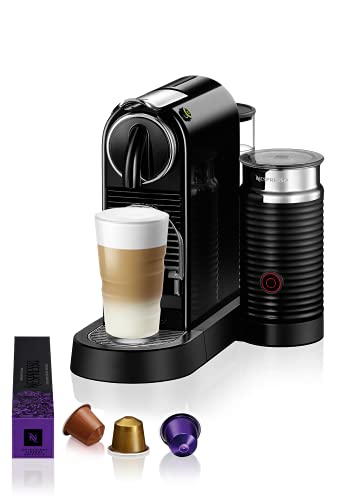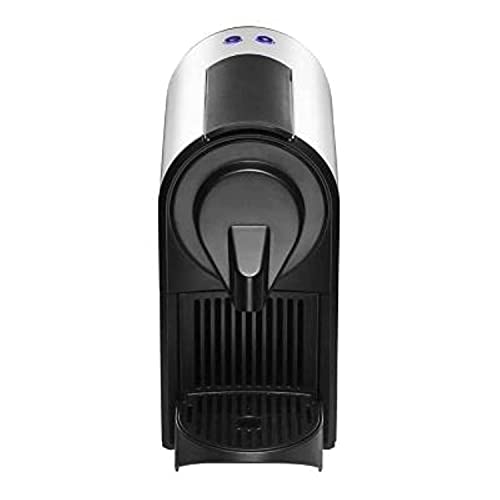 Nespresso Coffee – The Essenza Mini
Nespresso Coffee – The Essenza Mini
The Essenza Mini is compact, inexpensive and user-friendly. It doesn’t have features like the water tank and drip tray with a removable drip tray to remain small, but it makes excellent lungo and espresso.
 It operates by piercing capsules, and pumping hot water under pressure to make different drinks of espresso and nepresso coffee machines sizes, like the 1.35-ounce espresso, 2.7-ounce double espresso, 5-ounce gran lungo, or 14-ounce alto. It can be used with a milk frother that is freestanding.
It operates by piercing capsules, and pumping hot water under pressure to make different drinks of espresso and nepresso coffee machines sizes, like the 1.35-ounce espresso, 2.7-ounce double espresso, 5-ounce gran lungo, or 14-ounce alto. It can be used with a milk frother that is freestanding.
Capsules
The Nespresso system allows you to brew coffee at the touch of a button. You can select a single-serving size or a larger cup, and each capsule has the proper amount of ground beans to meet the strength you want. You can also add milk powder to make a cappuccino, latte macchiato, or other drinks. The capsules are constructed of completely biodegradable materials and can be recycled or disposed of guilt free.
The pods are constructed of aluminium and can withstand the high pressure of the machine. The pods are sealed and cannot be altered with. The coffee grounds stay fresh, safe from moisture and oxygen. Nestle’s environmental goals are in line with the fact that aluminium is 100% recyclable.
However, the system is not without its flaws. The machines are costly to buy and to operate. Additionally capsules can be costly to buy, and they have to be replaced often. Additionally, the machines are only compatible with Nespresso-branded capsules. This has led to several lawsuits between Nestle, and third-party companies which use the same extraction methods and ingredients as Nespresso.
Despite these disadvantages, the Nespresso system has many benefits which include premium coffee and sustainability for the environment. It’s an excellent alternative to regular coffee and tea, and also has a higher extraction rate than many single-serve systems. A single capsule can produce up to 14 ounces of espresso coffee.
The first capsule design was invented in 1976 and was patented in 1979. The main characteristics of the capsule are an cone of aluminum that has a flat top and an elongated recess which the machine pumps water, and a tiny opening in the bottom that’s punctured both above and below. The machine then spins the capsule at 7700 rpm to infuse the coffee with water and create a thick crema.
Water
It is crucial to use high-quality water when making use of a Nespresso. This is important for consistency and also for the flavor and texture. It is recommended to use “filtered” water or “spring water,” and avoid tap water or distilled water.
In our lab tests, we’ve found that Nespresso machines with high-quality softened water produce more enjoyable espressos and lungos than those that use hard water. This is because the hard water can cause calcium deposits and other problems that degrade the flavor of your coffee.
Each time you drink a cup of coffee, the Nespresso machine is able to take in and pumps out hot water at high pressure. This process is known as extraction. The duration, temperature, and pressure of the extraction process are what determines the flavor and strength of your coffee.
The original machines pierce and then the capsule and pump it up, whereas the Vertuo models read barcodes that are printed on the capsules to determine the amount of water required for a specific type of espresso. The Vertuo models can make six different drink sizes, including lungos and espressos, with or without a cap of foam.
All machines included in the Nespresso line can produce 19 bars. Some of the more expensive models also make cappuccinos and macchiatos with latte, and some even offer the option to make cold coffee.
Inissia machines and U-series machines are both compact which makes it easy to fit them into small spaces. The Nespresso Pixie is another compact option, with a built-in milk frother. It can also be integrated with the white nespresso machine app to access customized recipes and reorder capsules. Nespresso is a good choice for anyone looking to reduce their carbon footprint and support the company’s sustainability programme.
Temperature
Nespresso machines are more complex than your typical coffee maker but they are also designed to be speedy and simple to use. Each capsule is made in just a few seconds. They are also relatively energy efficient. Unlike traditional drip coffee makers which use more electricity per cup of coffee, Nespresso machines only use a small amount of power to brew each capsule.
Most Nespresso coffeee machine are designed for espresso-based drinks, but some models have a milk frother that can be used to make cappuccinos or lattes. Some of these models also have a separate capsule container that can hold up to 12 empty capsules at a time which makes them simple to recycle.
The Nespresso brand is supported by a number of well-known kitchen equipment manufacturers such as Krups, DeLonghi and Breville. However the majority of machines are manufactured by Eugster/Frismag which is a Swiss company that is one of the world’s largest coffee-machine producers. This has resulted in criticism of Eugster/Frismag for using patents and other methods similar to those used by printer manufacturers to create vendor lock-in.
Pressure
In order to make the most flavorful espresso it is essential to ensure that you maintain a consistent pressure throughout the extraction process. This is known as “pressure profiling.” Pressure profiling is the process of altering the amount of pressure that is applied to the coffee grounds in order to get the best extraction and to maximize flavor. This method is possible through the use of various espresso machines, such as Nespresso coffee makers.
There are a number of different ways espresso machines manipulate pressure during extraction. One way is to use a balanced bypass that regulates the pressure of water to a set amount (typically 9 bar), regardless of the inlet pressure. This is a simple, effective method that ensures that all of the espresso groups are at the same pressure throughout the extraction process.
A lever or control knob can be used to adjust pressure manually. This is a more difficult method, but it can provide a greater degree of control and customization. Manual pressure regulation can produce inconsistent results. It requires a lot of expertise and focus.
Certain espresso machines employ an adjustable pump that adjusts the pressure based on the temperature of the coffee grounds and the type of machine being used. This system is more advanced, but can produce better results than other types.
Nespresso offers a variety of machines which can be used to create coffee, lungo drinks and some of them can also froth milk. The Nespresso Inissia makes a great machine for baristas at home. It can make anywhere from 7 to 9 espressos at a time and has an ice tank that holds 33 ounces. It has buttons to select different sizes of drinks, and a capsule tray which can hold up to nine used pods. The Nespresso Vertuo Next is designed to be versatile and comes with a range of 11 milk temperatures and eight textures to choose from. It also comes with an stainless steel milk frother as well as the container that can hold up to 18 inches.
Cleaning
When you use a Nespresso machine it will leave behind tiny limescale and mineral residues every time you make a cup. These may get mixed with your coffee, causing it to taste bad. It is essential to clean your Nespresso machine regularly, as well as all its parts. The removable components like the drip tray capsule container, washer and drip tray should be cleaned and descalked in a thorough clean. A regular rinse of the capsule container using fresh water can also help prevent mineral buildup.
De-scaling solutions can help eliminate mineral deposits from your machine. These products are available in most appliance and coffee shops. You can also use vinegar. This abrasive cleaner won’t cause damage to your machine, however it may take a little longer to dissolve the minerals than a descaling solution.
If you choose to use vinegar, you should first take out the coffee pods and empty the reservoir of water. Get rid of all the water in the tank, including any filters. Pour the vinegar into the tank and run a cycle with out coffee pods so that it can pass through the machine. Then, rinse with clean water and run several more cycles to ensure there is no trace of vinegar left in the machine.
After cleaning your machine, clean the exterior and removable parts. Pay special attention to the corners and crevices where gunk may hide. You can either wash the parts that are removable with mild soap in your dishwasher or by hand. Rinse them thoroughly. It is also recommended to check the seals around the capsule and coffee outlet and replace them as necessary to ensure their elasticity and prevent leaks.

 by james05c968444
by james05c968444